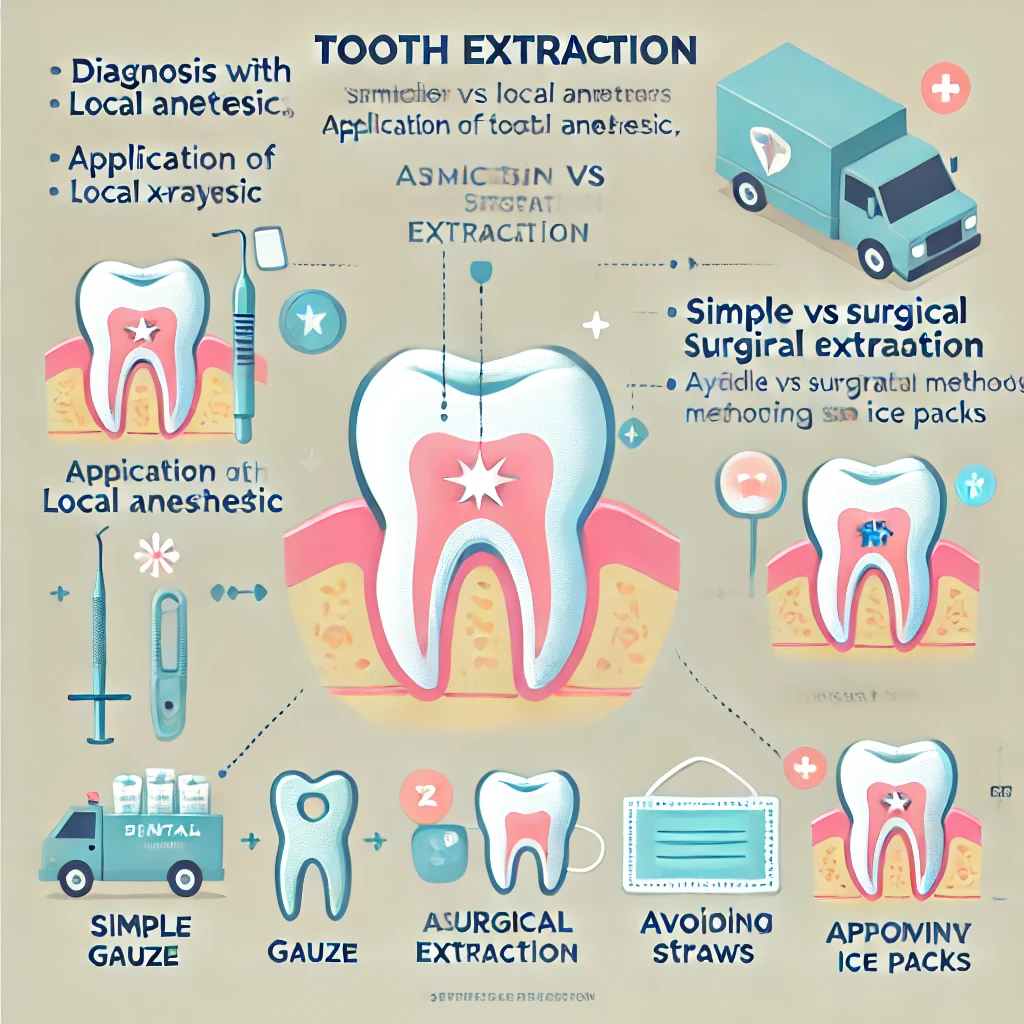Tooth extraction is a common dental procedure involving the removal of a tooth from its socket in the bone. While it may sound intimidating, modern dentistry techniques make it a straightforward and generally safe procedure. This article covers everything you need to know about tooth extractions, including reasons for extraction, the procedure itself, recovery tips, and FAQs.
What Is Tooth Extraction?
Tooth extraction is a procedure performed by a dentist or oral surgeon to remove a tooth due to various reasons, such as decay, infection, or overcrowding. The procedure can be classified into two types:
- Simple Extraction: For visible teeth that can be removed using forceps.
- Surgical Extraction: For teeth that are not easily accessible, such as impacted wisdom teeth, requiring an incision into the gum.
Reasons for Tooth Extraction
- Severe Tooth Decay or Infection: When the damage is beyond repair, removing the tooth may prevent the infection from spreading.
- Periodontal Disease: Advanced gum disease can weaken teeth and supporting bone, necessitating extraction.
- Crowded Teeth: Extraction may be required before orthodontic treatments to create space for proper alignment.
- Impacted Teeth: Teeth that fail to emerge properly, such as wisdom teeth, often require surgical removal.
- Trauma or Damage: Teeth that are severely fractured or damaged may need to be removed.
- Preventive Removal: In some cases, teeth are removed to prevent future dental complications.
The Tooth Extraction Procedure
- Consultation and Diagnosis
- The dentist will perform an oral examination, possibly including X-rays, to assess the condition of the tooth and surrounding bone.
- A treatment plan is discussed, including post-extraction care.
- Preparation
- Local anesthesia is administered to numb the area.
- For surgical extractions, sedation or general anesthesia may be used.
- Extraction Process
- For simple extractions: The tooth is loosened using an instrument called an elevator, then removed with forceps.
- For surgical extractions: The dentist makes an incision in the gum, sometimes removing bone or sectioning the tooth for easier extraction.
- Post-Extraction Care
- The dentist may place stitches to close the surgical site.
- Gauze is applied to control bleeding.
Recovery and Aftercare
Proper aftercare ensures a smooth recovery and minimizes complications such as dry socket or infection.
- What to Expect Post-Extraction
- Mild pain, swelling, and minor bleeding are normal.
- Recovery time varies but typically takes a few days to a week.
- Essential Aftercare Tips
- Bite down gently on gauze for 30–45 minutes to stop bleeding.
- Avoid spitting, drinking through a straw, or smoking to prevent dry socket.
- Use ice packs to reduce swelling.
- Stick to soft foods and avoid hot or spicy items for the first 24–48 hours.
- Take prescribed or over-the-counter pain medication as directed.
- Signs of Complications
- Severe pain, prolonged bleeding, or swelling could indicate infection or other issues. Contact your dentist immediately.
FAQs About Tooth Extraction
1. Is tooth extraction painful?
Modern anesthesia ensures that the procedure itself is virtually pain-free. Post-extraction discomfort can be managed with medication.
2. How long does it take to heal?
Most patients recover within a week, though complete healing of the socket may take several weeks.
3. What can I eat after a tooth extraction?
Stick to soft foods like yogurt, applesauce, mashed potatoes, and soups. Avoid hard, crunchy, or sticky foods during recovery.
4. Can I go back to work after a tooth extraction?
For simple extractions, most people can resume work the next day. Surgical extractions might require a day or two of rest.
5. Do I need a replacement for the extracted tooth?
If the extracted tooth is not a wisdom tooth, your dentist may recommend options like implants, bridges, or dentures to maintain proper bite and alignment.
Conclusion
Tooth extractions are a routine part of dental care and can help address a range of oral health issues. Understanding the procedure, following your dentist’s advice, and practicing diligent aftercare can ensure a smooth recovery. If you’re facing the prospect of a tooth extraction, consult a trusted dental professional for personalized advice and care.
Related:
How long does it take to recover from tooth extraction?
Is tooth extraction very painful?
Does the nerve come out when a tooth is pulled?
What happens if you have a tooth pulled and don’t replace it?
